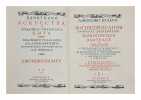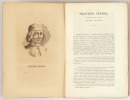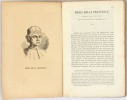79 books for « vasari »Edit
-
Language
French (77)
Italian (1)
Russian (1)
-
Century
16th (1)
18th (1)
19th (13)
20th (31)
21st (5)
-
Countries
Belgium (10)
Canada (5)
France (54)
Italy (3)
Switzerland (5)
United Kingdom (1)
United States of America (1)
-
Syndicate
ALAC (5)
CLAM (2)
ILAB (44)
SLAM (30)
Topics
- Architecture (5)
- Artists (1)
- Arts pc (1)
- Biography (4)
- Drawings (2)
- Epistemology (1)
- Fénéon félix (1)
- Fine arts (9)
- First edition (1)
- Florence (2)
- Fra angelico (1)
- Germanic languages (2)
- Giotto (1)
- Industrial arts & crafts - fine arts (1)
- Italian (8)
- Italy (4)
- Literature (1)
- Mazenod (2)
- Methodology (1)
- Modern times (1)
- Painters (6)
- Painting (1)
- Painting (6)
- School (1)
- Sculpture (5)
- Sportsmen (1)
- Testimonies / stories (1)
- Translation (1)
- Vinci léonard de (1)
Ragionamenti del Signor Cavaliere Giorgio Vasari Pittore e Architetto Aretino . . . Seconda Edizione.
Vasari, Giorgio: Ragionamenti del Signor Cavaliere Giorgio Vasari Pittore e Architetto Aretino . . . Seconda Edizione. Arezzo: Michele Bellotti, 1762. Quarto. Contemporary limp paper, manuscript title to spine. Contemporary or near-contemporary library ticket to the front pastedown. Half title, engraved portrait frontispiece, title printed in red and black with allegorical engraving, engraved historiated initials and head and tail-pieces. Head of spine repaired, small area of worming to the lower cover, 19th-century library ink stamp partially washed from the lower corner of the frontispiece, occasional light spotting, but overall contents fresh and largely unopened. Second edition, originally published posthumously in 1588 and reprinted in 1619 under the title Treatise on Painting. Though himself a painter and architect, Giorgio Vasari (1511-1574) is now best known as the founder of art history. He wrote the first, and certainly the most influential, collection of artists' biographies, Le Vite de' Piu Eccellenti Pittori, Scultori, E Architettori, and was responsible for promoting the modern concept of the Renaissance. He was so influential that almost every art historian in the century after Vasari wrote at least partially in response to his ideas. The present volume is about Vasari's own work, in particular the allegorical meanings of his frescoes in the Palazzo Vecchio in Florence, which were commissioned by Cosimo de' Medici, as well as other aspects of the palazzo's decorative scheme and contents, including ancient artefacts. The text is written as a dialogue between the author and the young Francesco de' Medici, and it elucidates much of Vasari's artistic and critical philosophy. This is a particularly nice copy, the contents fresh and largely unopened. Text in Italian.
Second edition, originally published posthumously in 1588 and reprinted in 1619 under the title Treatise on Painting. Though himself a painter and architect, Giorgio Vasari (1511-1574) is now best known as the founder of art history. He wrote the first, and certainly the most influential, collection of artists' biographies, Le Vite de' Piu Eccellenti Pittori, Scultori, E Architettori, and was responsible for promoting the modern concept of the Renaissance. He was so influential that almost every art historian in the century after Vasari wrote at least partially in response to his ideas. The present volume is about Vasari's own work, in particular the allegorical meanings of his frescoes in the Palazzo Vecchio in Florence, which were commissioned by Cosimo de' Medici, as well as other aspects of the palazzo's decorative scheme and contents, including ancient artefacts. The text is written as a dialogue between the author and the young Francesco de' Medici, and it elucidates much of Vasari's artistic and critical philosophy. This is a particularly nice copy, the contents fresh and largely unopened. Text in Italian
Vasari D. Vazari D., Zhizneopisaniya naibolee znamenitykh zhivopistsev, vayatele
"In Russian. Short description: Vasari D., Lives of the Most Eminent Painters, Sculptors, and Architects. Volumes I-II, Moscow-Leningrad, 1933. Translated and annotated by Yu. Verkhovsky, A. Gabrichevsky, B. Griftsov, A. Guber, A. Dzhivelegov, and A. Efros, with a preface by A. Lunacharsky, edited and introduced by A. Dzhivelegov and A. Efros, designed by I. Rerberg. ""Lives of the Most Eminent Painters."" by the Italian painter and architect Giorgio Vasari (1511-1574) is a book that marks the beginning of the history of art in Europe. Both in content and form, it has long been considered a classic. The work contains biographies of famous Italian painters, architects, and sculptors of the Renaissance era, including Cimabue, Paolo Uccello, Masaccio, Filippo Brunelleschi, Donatello, Raphael, Titian, Michelangelo, and others. The books also include numerous factual details about the artistic life in Italy. Reproductions of paintings, photographs of sculptures, and architectural monuments are published on separate pages of coated paper. Giorgio Vasari was a courtier of the ruler of Florence, Cosimo de' Medici, and was an artist, art historian, and connoisseur of art and biography. In the original, his work consists of many volumes, but only the most significant portions of the ""Lives of the Most Eminent Painters"" were translated into Russian. Please feel free to contact us for a detailed description of the copies available. SKUMS001820"
Vies des peintres, sculpteurs et architectes par Georgio Vasari traduites par Léopold Leclanché et commentées par Jeanron et Léopold Leclanché
Just Tessier | Paris 1841-1842 | 14.50 x 22.50 cm | 10 tomes en 10 Vol. reliés
Première édition complète. L'entreprise éditoriale démarra en 1839, mais la publication s'étendit bien de 1841 jusqu'en 1842 pour les derniers tomes. Illustrée de 121 portraits lithographiés de Jeanron. Reliure en demi chagrin vert sapin d'époque. Dos à nerfs à caissons ornés. Pièces de titre et de tomaison dorées. Filets noirs et filets dorés. Un léger manque à une tête. Légères traces de frottements. Belle série décorative. Exemplaire relativement frais, avec quelques rares rousseurs pâles éparses. Vasari (1511-1574) est l'auteur du précieux et très fameux recueil intitulé Les vies des plus excellents peintres, sculpteurs et architectes italiens (Le Vite de' più eccellenti pittori, scultori e architettori italiani) (1550-1570). Il est le premier à utiliser le terme Renaissance pour qualifier son époque. Cet ouvrage mythique est d'une importance fondamentale car il pose les prémisses méthodologiques de l'Histoire de l'art. Il rassemble les biographies des peintres italiens de Cimabue à Michel-Ange. En outre, Vasari réalisera pour les Médicis le corridor qui reliera le palazzo Vecchio au palazzo Pitti. - Photographies et détails sur www.Edition-Originale.com -


Phone number : 01 56 08 08 85
Les vies des meilleurs peintres, sculpteurs et architectes de Giorgio Vasari, tome 12. Vasari illustré
Berger-Levrault, coll. « Du texte à l’image » 1989 In-8 broché 21,7 cm sur 13,7. 456 pages. Bon état d’occasion.
Édition commentée sous la direction d’André Chastel Bon état d’occasion
Ragionamenti. Sopra le inuentioni da lui dipinte in Firenze nel Palazzo di loro Altezze Serenissime. Con lo illustriss & Eccelentiss Signor Don Francesco Medici allora Principe di Firenze. Insieme con la inuentione della Pittura da lui cominciata nella Cupola.
Florenz, Filippo Giunti, 1588. Kl.-4°. (4) Bl., 186 S., (9) Bl. Mit Holzschnitt-Portrait, 2 versch. Holzschnittdruckermarken und zahlr. Holzschnitt-Initialen. Flexibler Pergamentband der Zeit mit 2 Schliessbändern (2 Seiten ausgerissen), handschr. Rückentitel und Papierrückenschild.
Brunet V, 1097. – Cicognara 225. – Erste Ausgabe. War schon 2 Jahre vor Giorgio Vasaris Tod (1511-1574) druckfertig, wurde vom gleichnamigen Neffen aus dem Nachlass herausgegeben. Die insgesamt sieben Dialoge, den einzelnen Sälen, mit Malereien von Vasari, im Palazzo Vecchio gewidmet, zwischen Vasari und Francesco Medici, dem damaligen «Principe» der Stadt Florenz.– Papier durchgehend stockfleckig. 7 Blatt stärker gebräunt. Der Einband leicht fleckig.

Phone number : 41 (0)44 261 57 50
Giorgio Vasari, il Giovane. Raccolto fatto dal Cav. Giorgio Vasari di varii instrumenti per misurare con la vista. Introduzione e cura di Filippo Camerota. Biblioteca della scienza italiana, XIV.
Firenze, Giunti Gruppo Editoriale 1997, 240x170mm, 423pagine, in brossura. Sovracoperta. Copia nuova condizione.
Pour un paiement via PayPal, veuillez nous en faire la demande et nous vous enverrons une facture PayPal
Les vies des plus excellents peintres, sculpteurs et architectes. Traduction nouvelle par Charles Weiss.Tome I seul;
PARIS, Dorbon-Ainé - Volume In-8 ° broché, dos fatigué - Introduction VII à XI - 479 pages - Reproduction au Tome I de la couverture de l’original (1568) --
il faut 2 volumes, Remise de 20% pour toutes commandes supérieures à 200 €
Vie des grands artistes [Board book] Giorgio Vasari
Relié bon état .Contenu propre . Exemplaire numéroté .Nom au stylo .522 pages . 1954. PHOTOS SUR DEMANDE
Merci de nous contacter à l'avance si vous souhaitez consulter une référence dans notre boutique à Authon-du-Perche.
Vie des grands artistes [Library Binding] Giorgio Vasari
Relié bon état Contenu propre . Ex. numéroté . Dos insolé . 522 pages . 1954. PHOTOS SUR DEMANDE
Merci de nous contacter à l'avance si vous souhaitez consulter une référence dans notre boutique à Authon-du-Perche.
Vies des peintres numro 2
Les Belles Lettres Broch D'occasion tr¿s bon tat 15/11/2002 190 pages
Traité de la peinture. Réimpression intégrale de l'édition italienne de Bologne (1786) d'après celle de 1651, publiée à Paris par Raphaël Trichet du Fresne. Texte illustré de 16 planches gravées d'après les dessins de Nicolas Poussin. Nouvelle traduction française par André KELLER, diplômé de la Société Dante Alighieri de Rome, comportant la reproduction des croquis et des dessins du grand maître. La Vie de Léonard de Vinci est de Giorgio VASARI, peintre et écrivain florentin.
Jean de Bonnot, Paris, 1977, in-4 relié plein cuir richement orné, dorures, tranche supérieure dorée, signet, environ 450 pp, nombreuses illustrations. Tirage de tête. TRES BON ETAT
LE VITE DE' PIU' ECCELLENTI PITTORI, SCULTORI ET ARCHITETTORI.
Prima stampa commentata e riccamente illustrata a cura di Pio Pecchiai. Sonzogno, Milano, 1928-1930. In-4 p., 3 volumi, tela coeva, tit. oro su doppio tassello al dorso, pp. LXIII,1932; XLV,1101; LXIII,1119; testo su due colonne, con una ricchiss. documentazione fotografica in b.n. nel t. per lo più relativa alle opere degli artisti trattati. Ristampa annotata della seconda edizione delle Vite vasariane, pubblicata dai Giunti a Firenze nel 1568, e di cui vengono riprodotti anche tutti i ritratti. Prima e unica edizione illustrata delle Vite. Volume primo con le prime 2 carte restaurate con nastro adesivo (per strappi); pagine lievemente ingiallite ai margini per la qualità della carta, altrimenti ben conservato.
Le opere die Giorgio Vasari con nouve annotazioni e commenti di Gaetano Milanesi (1818-1895).
9 Bände. Firenze, Sansoni, 1880-1885. 8°. Spätere Halbpergamentbände, bzw. mod. Leinenband (Band I).
Bibliotheksexemplar mit Nummern, Klebern, Etiketten und mehrfach gestempelt.
LIVES OF THE MOST EMINENT PAINTERS, SCULPTORS AND ARCHITECTS, VOL. III
Henry G. Bohn. 1851. In-12. Relié. Etat d'usage, Couv. légèrement passée, Mors fendus, Intérieur acceptable. 526 pages. Couverture se détachant légèrement.. . . . Classification Dewey : 420-Langue anglaise. Anglo-saxon
Trans. from the Italian of Giorgio Vasari, With Notes and illustrations, Chiefly selected from various commentators, by Mrs. Jonathan FOSTER. Classification Dewey : 420-Langue anglaise. Anglo-saxon
OPERE DI GIORGIO VASARI, PITTORE E ARCHITETTO, 6 TOMES (COMPLET)
S. Audin e C., Firenze. 1822-1823. In-16. Relié. Bon état, Couv. convenable, Dos satisfaisant, Quelques rousseurs. 6 tomes. Plusieurs paginations. Illustrés de nombreuses gravures en noir et blanc sur planches hors texte (portraits). Titres et tomaisons dorés sur les dos. Etiquettes de code sur les couvertures. Quelques tampons de bibliothèque.. . . . Classification Dewey : 450-Italien, roumain, rhéto-romain
Dell'Architettura. Della Scultura. Della Pittura. Vite degli Artefici. Ragionamenti sopra le invenzioni dipinte in firenze nel Palazzo Vecchio... Classification Dewey : 450-Italien, roumain, rhéto-romain
CAPRICCI E ANEDDOTI DI ARTISTI
G. Barbèra, Firenze. 1878. In-32. Relié demi-cuir. Bon état, Couv. convenable, Dos à nerfs, Quelques rousseurs. 471 pages. Auteur, titre, fleurons, roulettes et filets dorés sur le dos. Etiquette de code sur la couverture. Quelques tampons de bibliothèque. Dos légèrement insolé.. . . . Classification Dewey : 450-Italien, roumain, rhéto-romain
Descritti da Giorgio Vasari. Classification Dewey : 450-Italien, roumain, rhéto-romain
Les Vies des meilleurs peintres, sculpteurs et architectes. 11 Volumes
Berger-Levrault Couvertures souples Paris 1981
Très bon 11 volumes in-8, paginations diverses. 1981-1987. Complet en 11 volumes incluant l'index, mais sans le volume 12 : "Du texte à l'image - Vasari illustré". Bel ensemble.
Le vite de piu eccellenti pittori scultori e architetti di Giorgio Vasari - 4 tomes en 2 volumes - Seconda edizione.
Tip. dell'oratorio di S.Franc.di Sales. 1871. In-16. Relié. Etat d'usage, Couv. convenable, Dos satisfaisant, Intérieur acceptable. 291+226 pages + 254+340 pages - tranches bordeaux - contre plats jaspés - étiquette collée sur la coiffe en pied - ouvrages en italien.. . . . Classification Dewey : 450-Italien, roumain, rhéto-romain
Ouvrages en italien - Volume 1 : Tomes 1 + 2 - Volume 2 : Tomes 3 + 4. Classification Dewey : 450-Italien, roumain, rhéto-romain
Sept vies d'artistes plus celle de l'auteur.
Paris, NRF, Gallimard (Collection "La Renaissance"), 1929, in 12 broché, 221 pages ; 5 portraits hors-texte ; signature sur le titre.
Exemplaire du Service de Presse. Lippi - La Cecca - Ghirlandaio - Botticello - Perugino - Bandinelli - Rustici - Vasari. ...................... Photos sur demande ..........................


Phone number : 04 77 32 63 69
VASARI, Giorgio - Arezzo, 30 juillet 1511, Florence, 27 juin 1574 - Peintre, Architecte et Ecrivain italien auteur des Vite, premier recueil d'histoire de l'Art - Traduction par Charles WEISS
Reference : 72
Les Vies des Plus Excellents Peintres, Sculpteurs et Architectes , Alias" Le Vite de' più eccellenti Pittori, Scultori e Architettori
PARIS, Dorbon-Ainé - 2 Volumes In-8 ° brochés, dos fatigué - Introduction VII à XI - 937 pages - Reproduction au Tome I de la couverture de l'original (1568) -- Tome II, Vue dépliante de FLORENCE au XIV e - Ex. non coupé, Très frais intérieurement.
C'est l'ouvrage que Giorgio Vasari a consacré aux artistes de son temps, paru une première fois en 1550, puis, remanié, paru en 1568 à Florence. Souvent nommé Le Vite De'piu Eccellenti Architetti, Pittori, Et Scultori Italiani voire complété par Da Cimabue, Insino A' Tempi Nostri (ces mentions ne figurent toutefois pas sur la couverture de l'ouvrage). Il est le premier, dans Le Vite, à utiliser le terme Renaissance pour qualifier son époque. Cet ouvrage apparaît, aujourd'hui, comme un des éléments fondateurs de l'Histoire de l'art.
Le Vite de' più eccellenti pittori, scultori et architetti, di Giorgio Vasari, pubblicate per cura di una Società di amatori delle Arti belle. Volume VI
Firenze Felice Le Monnier 1850 in-12 broché Firenze, Felice Le Monnier, 1850. 18 x 12 cm, in-12, (4) 352 pp. - 4 planches hors texte, broché sous couverture saumon imprimée.
Volume 6 des 14 parus. Concerne Francesco Francia, Pietro Perugino, Vittore Scarpaccia, Iacopo dello l'Indaco et Luca Signorelli. Dos bruni et quelques rares rousseurs. Bon
Le Vite de' più eccellenti pittori, scultori et architetti, di Giorgio Vasari, pubblicate per cura di una Società di amatori delle Arti belle. Volume IV
Firenze Felice Le Monnier 1848 in-12 broché Firenze, Felice Le Monnier, 1848. 18 x 12 cm, in-12, (4) 255 pp. - 20 planches hors texte, broché sous couverture saumon imprimée.
Volume 4 des 14 parus. Concerne 21 artistes italiens, de Giuliano de Maiano à Ercole Ferrarese. Dos bruni et quelques rares rousseurs. Bon
OEUVRES COMPLÈTES DE BENVENUTO CELLINI. Orfèvre et sculpteur florentin. Traduites par Léopold Leclanché, traducteur de Vasari - 2 volumes.
Paulin 12 x 18 Paris 1847 Deux volumes, petit in-8°, demi-basane verte d'époque, dos disparates l'un avec filets dorés, l'autre avec fleurons, deuxième édition, 366 et 424 p. Tome I. Mémoires. Tome 2 : Suite des mémoires. Traités de l'orfévrerie et de la sculpture. Discours sur le dessin et l'architecture. Reliures usées, nombreux soulignements ou commentaires au crayon de papier, rousseurs, mais solide et bon exemplaire de travail. Livre
Les Vie Des Meilleurs Peintres , Sculpteurs et Architectes Tome 6
Paris Berger Levrault 1984 In8 327pages - broché - bon etat - dos marqué d un pli
Bon
 Write to the booksellers
Write to the booksellers









